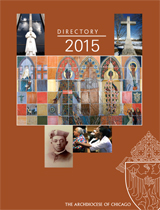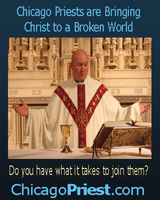November 22, 2009
Advent: Make room in homes, hearts during busy time This season is for hope, not anxiety
How are you?” “Busy.” That response cloaks a low spirit, beaten down by many responsibilities, opportunities and longings.
Many people are so busy with the day’s work that they lose track of the goal of their lives. Over time, values get lost. Priorities get shifted. Dreams are abandoned. All because people are busy.
The weeks before Christmas are among the busiest of the year. The high expectations of this holiday put stress on your relationships and cash flow, your faith and friendships. And all the while, you have to deal with the weather.
Everyone knows the meaning of Christmas. It commemorates the birth of Jesus. But not everyone lives the meaning of Christmas. Not everyone rejoices with its message of salvation for the sinner, its summons to show charity to your neighbor and its opportunity to adore the Lord.
This is a time of hope. But for many it is a time of anxiety.
Loss of the season
Advent struggles for attention. You have already been deluged by the sights, sounds and solicitations of the holiday season. And you still have several weeks to go. By the time Christmas gets here, many people are ready to throw out the tree, box up the decorations and lock the season back in the attic.
Something is wrong with this picture. The impatience that dogs holiday preparations outmaneuvers the patience of waiting for a Savior. Advent gets lost.
Many Christians bristle at the way society has seized Christmas and turned it into the holiday season. School children sing about snow. Merchants greet you with, “Happy Holidays.” Nativity scenes are banished from public squares. The start date for the season is pushed ever earlier. Halloween decorations are not down before holiday decorations go up.
You may have already spent many hours shopping, many occasions looking at holiday displays.
And it’s not even Advent. Ironically, the holiday season may be the best thing that’s ever happened to Christmas. It separates its material and spiritual purposes.
This is not just a time to review the past year, to go into debt, or to obtain what others already have. It is a time to nurture the spirit, to think about Jesus, his miraculous coming, his challenging message and his love for you.
Treasure customs
To make the most of Advent, you don’t have to run away from your customs. Go into them, but do them with the right attitude. Almost every Christmas custom has a Christian origin. By rediscovering these, you can add more depth to your preparations.
So, start by listing your Advent customs. Some are spiritual, but others have a more mundane purpose. At this point, it doesn’t matter. Just list them. List what you try to do year after year during this season.
The repetition of these customs has already formed your heart and your head. You feel and think about this season in a personal way because of your annual observance.
Some of your customs specifically deal with the Advent season. For example, many homes display an Advent wreath. This evergreen circle utilizes a plant that survives the winter, assuring you that you can survive the winters of life.
During each of the four weeks of Advent you light one more candle, showing the determination of light to break through the darkness of this season and to bestow a spirit of festive joy.
Do you set up an Advent wreath in your home? How do you make it? When do you light the candles? Do you say some prayers when you do so? What is your custom about the wreath?
Prayer books, calendars
Other people use a daily prayer book for this season, one that offers a spiritual reflection day after day. Do you use such a resource? How do you say daily prayers in the weeks before Christmas?
Some homes post an Advent calendar. Each day you lift a flap that reveals a symbol of the season. Children especially enjoy opening up the doors of the calendar, uncovering more of its beauty from day to day.
A Jesse tree shows many of the figures from Jesus’ genealogy.
Just as the Gospel according to Matthew and the Gospel according to Luke record the generations leading up to the birth of Christ, so a tree can be decorated with the people of his ancestry who foreshadowed his coming: for example, Adam and Eve, the first couple; Moses, who led people from slavery to freedom; Ruth, whose selfless love typified family life; and David, who ruled as king of Israel.
Do you perform some service each Advent? Is it your tradition to visit a nursing home, volunteer at a soup kitchen or help a neighbor in need?
Structuring time
Advent has two purposes. It prepares us for the annual celebration of the birth of Christ, but it also prepares us for his second coming. Many people assume that Christmas merely looks back to the first coming of Jesus in Bethlehem, but it also looks forward to his return at the end of time.
Advent begins on the fourth Sunday before Christmas. It always includes four Sundays, but it rarely runs for four full weeks. In the Catholic Church, the priest and deacon wear purple vestments during the season’s liturgies, but on the Third Sunday of Advent, they may wear rose.
The candles of an Advent wreath adopt the same color scheme. Usually, you see three purple candles and one colored pink, which you light on the third week of the season.
The colors have a simple interpretation. Purple reminds us that this is a season of anticipation, similar to Lent. Lent invites repentance more than Advent does, but the color is meant to contrast with the brilliant white vestments of Christmas.
The rose-colored vestments signal that the season is about halfway over. The end is near. The day for which we have longed will soon dawn.
An end and coming
The Gospel readings assigned to the four Sundays express this double meaning of Advent. On the First Sunday, it warns us about the end of time. On the Second and Third Sundays, they introduce John the Baptist, who prepared his contemporaries for the message of Jesus.
The Gospel of the Fourth Sunday tells part of the story leading up to the birth of Christ. The Gospel readings of Advent go backward in chronology. They start with the future and they end with the past.
John the Baptist stands in the middle. At weekday Mass the readings follow a similar pattern. The season opens with a series of Old Testament prophecies that are realized in the ministry of Jesus. Starting on Thursday of the Second Week of Advent, the Gospel readings all mention John the Baptist. For the last eight days of Advent they tell the story of the events leading up to the birth of Jesus. On the weekdays, also, the Gospel stories turn us around. They start with the adult Jesus and they end with the conception of Jesus. John the Baptist stands in the middle.
Through the readings of Advent, we prepare to remember the birth of Jesus, but not before entering a broader context. Jesus is coming again. That is why we prepare.
Text excerpted from “What Am I Doing for Advent for This Year?” published by Liturgy Training Publications. The booklet can be purchased for $1 at www.ltp.org or by calling (800) 933-1800.
 Catholic
New World - Newspaper for the Archdiocese of Chicago
Catholic
New World - Newspaper for the Archdiocese of Chicago Archdiocese of Chicago Directory
Archdiocese of Chicago Directory Oficjalne wydawnictwo Archidiecezji Chicago w języku polskim
Oficjalne wydawnictwo Archidiecezji Chicago w języku polskim